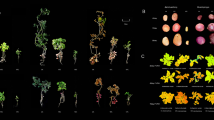Abstract
The present experiment was conducted with two popular potato (Solanum tuberosum L.) cultivars of north-east India namely ‘Kufri jyoti’ and ‘Kufri megha’ with the objective to study the biochemical changes in response to high temperature. Parameters such as total chlorophyll, chlorophyll a/b ratio, proline content, total amino acid content, total soluble sugar content, lipid peroxidation and total superoxide dismutase activity were studied during the growth of the potato crop. The study revealed that high temperature has a significant impact on these parameters. The treatment × variety interaction was found to be significant (p ≤ 0.01) for proline content, total soluble sugar content and superoxide dismutase activity at most of the growth stages, and can be taken as marker traits for selection of heat resistant potato varieties. Variety Kufri jyoti was found to be more sensitive to high temperature leading to significant reduction in crop yield compared to Kufri megha.





Similar content being viewed by others
References
Ahmed, A., Rajeev, N. B., Sangeeta, K., & Madan, P. S. (2011). Higher gylcine betaine and antioxidant enzymes activity are associated with high temperature tolerance in potato. Indian Journal of Plant Physiology, 16, 285–293.
Almeselmani, M., Deshmukh, P. S., Sairam, R. K., Khushwaha, S. R., & Singh, T. P. (2006). Protective role of antioxidant enzymes under high temperature stress. Plant Science, 171, 382–388.
Anderson, J. M., & Boardman, N. K. (1964). Studies on the greening of dark grown bean plants. II Development of photochemical activity. Biological Sciences, 17, 93–101.
Asada, K. (1997). The role of ascorbate peroxidase and monodehydroascorbate reductase in H2O2 scavenging in plants. In J. G. Scandalios (Ed.), Oxidative Stress and the Molecular Biology of Antioxidant Defenses (pp. 715–735). New York: CSHL Press.
Bates, H. D., Waldren, R. P., & Teare, E. D. (1973). Rapid determination of free proline in water stress studies. Plant Soil, 39, 205–208.
Buege, J. A., & Aust, S. D. (1978). Microtonal lipid peroxidation. Methods in Enzymology, 52, 302–310.
Chaitanya, K., Sundar, D., Masilamani, S., & Ramachandra, R. A. (2002). Variation in stress- induced antioxidant enzyme activities among three mulberry cultivars. Plant Growth Regulation, 36, 175–180.
Covey-Crump, E. M. (2002). Regulation of root respiration in two species of Plantago that differ in relative growth rate: The effect of short- and long-term changes in temperature. Plant Cell Environment, 25, 1501–1513.
Dekov, I. T., Tsonev, T., & Yordanov, I. (2000). Effects of water stress and high temperature stress on the structure and activity of photosynthetic apparatus of Zea mays and Helianthus annuus. Photosynthetica, 38, 361–366.
Dhindsa, R. S., Dhindsa, P., & Thorpe, T. A. (1981). Leaf senescence: Correlated with increased levels of membrane permeability and lipid peroxidation, and decreased levels of superoxide dismutase and catalase. Journal of Experimental Botany, 32, 93–101.
Hijmans, R. J. (2003). The effect of climate change on global potato production. American Journal of Potato Research, 80, 271–279.
Howarth, C. J. (2005). Genetic improvements of tolerance to high temperature. In M. Ashraf & P. J. C. Harris (Eds.), Abiotic stresses—plant vresistance through breeding and molecular approaches (pp. 277–300). New York: The Haworth Press.
IPCC (Intergovernmental Panel On Climate Change). (2007). Climate change and its impacts in the near and long term under different scenarios. In The Core Writing Team, R. K. Pachauri, & A. Reisinger (Eds.), Climate change impact of high-temperature stress on rice: Synthesis report (pp. 43–54). Geneva: IPCC.
Lafta, A. M., & Lorenzen, J. H. (1995). Effect of high temperature on plant growth and carbohydrate metabolism in potato. Plant Physiology, 109, 637–643.
Lugan, R., Niogret, M. F., Leport, L., Guegan, J. P., Larher, F. R., Savoure, A., et al. (2010). Metabolome and water homeostasis analysis of Thellungiella salsuginea suggests that dehydration tolerance is a key response to osmotic stress in this halophyte. Plant Journal, 64, 215–229.
Moore, S., & Stein, W. H. (1948). Polyphenol oxidase. In S. P. Colowick & N. D. Kaplan (Eds.), Methods in enzymol (Vol. 3, p. 468). New York: Academic Press.
Rui, R. L., Nie, Y. Q., & Tong, H. Y. (1990). SOD activity as a parameter for screening stress tolerant germplasm resources in sweet potato. (Ipomoea batatus L.) Jiangsu. Journal of Agricultural Science, 6, 52–56.
Sadasivam, S., & Manikam, A. (1992). Biochemical methods. New Delhi: Wiley Eastern Limited.
Sairam, R. K., Srivastava, G. C., & Saxena, D. C. (2000). Increased antioxidant activity under elevated temperatures: A mechanism of heat stress tolerance in wheat genotypes. Biology of Planta, 43, 245–251.
Sakamotto, A., & Muratta, N. (2002). The role of glycine betaine in protection of plants against stress: Clue from transgenic plants. Plant Cell Environment, 25, 163–171.
Saue, T., & Kadaja, J. (2011). Possible effects of climate change on potato crops in Estonia. Boreal Environment Research, 16, 203–217.
Savchenko, G. E., Klyuchareva, E. A., Abrabchik, L. M., & Serdyuchenko, E. V. (2002). Effect of periodic heat shock on the membrane system of etioplasts. Russian Journal of Plant Physiology, 49, 349–359.
Singh, J. P., Govindakrishnan, P. M., Lal, S. S., & Aggarwal, P. K. (2005). Increasing the efficiency of agronomy experiments in potato using INFOCROP-POTATO model. Potato Research, 48, 131–152.
Szabados, L., & Savoure, A. (2010). Proline: A multifunctional amino acid. Trends Plant Science, 15, 89–97.
Verbruggen, N., & Hermans, C. (2008). Proline accumulation in plants: A review. Amino Acids, 35, 753–759.
Wahid, A., Gelani, S., Ashraf, M., & Foolad, M. R. (2007). Heat tolerance in plants: An overview. Environmental and Experimental Botany, 61, 199–223.
Wolf, S., Marani, A., & Rudich, J. (1990). Effects of temperature and photoperiod on assimilate partitioning in potato plants. Annals of Botany, 66, 513–520.
Author information
Authors and Affiliations
Corresponding author
Rights and permissions
About this article
Cite this article
Paul, S., Gogoi, N., Sarma, B. et al. Biochemical changes in potato under elevated temperature. Ind J Plant Physiol. 19, 36–42 (2014). https://doi.org/10.1007/s40502-014-0066-y
Received:
Accepted:
Published:
Issue Date:
DOI: https://doi.org/10.1007/s40502-014-0066-y




